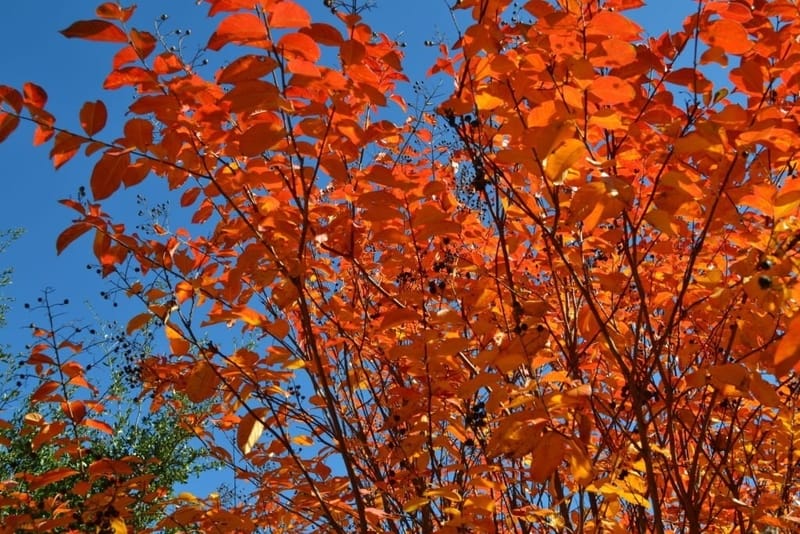The Pistacia Chinensis tree, also known as the Chinese Pistache, is a deciduous tree native to China. It is part of the cashew family Anacardiaceae and is characterized by its dioecious nature. The leaves are pinnately compound and the flowers are red with showy petals that bloom in spring.
This tree has beautiful blossoms that can be enjoyed throughout spring in most temperate regions of North America. And while it’s not an invasive plant like some other members of its family, it does need well-drained soil and lime in order to thrive properly.
The Chinese pistache tree is also known as an ornamental plant because of its beautiful appearance and leaf coloration. Its bright green leaves turn yellow or orange when they fall in autumn, which adds to its aesthetic appeal without detracting from its usefulness as a shade tree or windbreak.
Chinese Pistache Tree Pros
Beautiful fall color
The Chinese pistache tree’s fall color is a spectacular sight to behold. With a range of reds, oranges, and yellows, the tree becomes a vibrant pop of color in your yard during the autumn months which really stands out against the green grass in your yard.
Ideal for street or lawn tree
The Chinese pistache tree is ideal for use as a street or lawn tree. It’s also suitable for urban areas, especially where drought-tolerant plants are needed. The Chinese pistache can be used to beautify your property without requiring much care and maintenance. While the plant will thrive in different soil types, it has been shown that they do best when planted in well-drained soils that have adequate moisture throughout the year. They require less water than other trees because they are able to store water in their roots during dry periods so they don’t need as much watering during heavy rains from time to time.
Good Shade Tree
The Chinese pistache tree is a beautiful shade tree that can provide a lot of benefits to your yard. It is known for its beautiful display of flowers in the spring, but it also has strong, hardy branches and leaves that make it a great choice for many different kinds of climates.
High Drought Tolerant
The Chinese pistache tree is a very drought-tolerant plant. It can survive in dry, hot conditions and doesn’t require much watering or fertilizing. This makes it a great choice for people with little time or money to spend on their plants, or for those who live in areas where water is scarce.
Heat Tolerant
The Chinese pistache tree is an excellent choice for a sunny spot in your yard. This tree has some of the best heat tolerance in its class, making it ideal for hot climates.
If you’re looking for a tree that can withstand the heat and still look good, the Chinese pistache tree is your best bet.
This tree has an incredibly wide range of temperatures it can tolerate, from 15 to 40 degrees Celsius (59 to 104 degrees Fahrenheit). It also grows well in full sun or partial shade.
Tough Wood
Chinese pistache tree is a hardwood that is commonly used for construction projects like boat building and flooring applications where strength is important but weight needs to be kept down. It has a straight grain, fine texture and is deep brown in color with a very high resistance to decay.
Pests Resistant
The Chinese pistache tree is a beautiful and resilient tree that can grow in many different environments. It is considered pest resistant because it has no major pests or diseases which makes them less susceptible than other trees. This means that you can plant them in your yard without worrying about having to spray or treat them with chemicals!
Chinese Pistache Tree Cons
Fruits and leaves can be a bit messy
The Chinese pistache tree is a lovely addition to any garden, but it’s not without its drawbacks.
While the tree itself is a great choice for the landscape, it’s important to know what you’re getting into before you plant one in your yard.
Fruits and leaves can be a bit messy, as they fall off of the tree and land on the ground. They’re not a major problem, but they can be a little annoying to clean up. The leaves are small, so it’s not a big deal to sweep them up. The fruit is also small and easy to pick up.
Poor Soil Salt Tolerance
If you live in an area with a lot of ocean air, this may be an issue for you. While the tree does have a high tolerance for drought, it does not do well when there’s too much salt in the soil.
The roots of this tree tend to suffer from salt damage when exposed to high levels of salt in their environment. In fact, even low levels of soil salinity can cause problems for this plant’s root system. This can lead to plant stress, stunted growth, yellowing leaves and leaf drop.
Susceptible to Verticulum Wilt
Chinese pistache trees are susceptible to Verticillium wilt. The fungus that causes this disease can infect the roots and the trunk of your tree, and it can also spread through the soil. If your Chinese pistache is infected, you may notice symptoms like yellowing leaves, wilted leaves, and leaf drop.
The disease spreads easily between plants by infected water or soil, so it’s important to take care when working with these trees.
The disease can be prevented by planting trees in well-drained soil.
There are no known fungicides that can control this disease, but pruning infected branches can help limit its spread.
Susceptible To Oak Root Fungus
Chinese pistache trees are beautiful and resilient, but they can be susceptible to a fungal disease called oak root fungus.
Oak root fungus is a soil-borne fungus that affects the roots of plants. The disease is spread by spores that are carried in the soil on equipment and shoes, or through contaminated seeds or compost. Oak root fungus can also be spread by an infected tree’s roots reaching out into nearby soil and spreading the disease to healthy trees.
Oak root fungus causes browning and wilting of leaves, which eventually turn yellow, followed by death of the plant. It’s important to note that oak root fungus does not kill trees directly; it makes them more susceptible to other factors like drought or pest damage that would otherwise be survivable with healthy roots.
Oak root fungus is most common in warmer climates with moist soils or high rainfall, but the disease has been found in places as diverse as South Africa to California. It can be prevented by fungicide before they show signs of infection; keeping your garden free from fallen leaves and other debris in fall so as not to provide an ideal environment for fungi such as this one.
Also read: Ivory Silk Lilac Tree Pros And Cons
FAQS
Where to Plant Chinese Pistache Tree?
You’ll have to choose a good spot for your Chinese pistache tree, as they do best when they’re planted in a sunny area that has well-draining soil. If you’re planting it near other trees or plants, be sure to leave space between them and make sure there’s room for your new tree to grow up tall without getting crowded out by other plants around it.
When to plant Chinese pistache tree?
A good time to plant your Chinese Pistache is early spring before the weather gets hot and humid during late summer months throughout much of North America (fall planting times vary depending on where you live). Planting this particular type of Asian chestnut tree may require some special preparation beforehand; keep reading below for more information about caring for newly planted trees!
Conclusion
In conclusion, the Chinese pistache tree has a lot of things going for it. It’s beautiful, hardy and drought tolerant and those qualities make it an ideal choice for use as a street or lawn tree. However, like most plants, this one has its drawbacks too like shedding its small fruits on sidewalks and driveways. But the pros, however, far outweigh the cons, so if you’re looking for a tree that is beautiful and has many uses for your home and garden, then this is definitely one worth considering.
I hope you’ve enjoyed this guide to Chinese pistache trees.
If you have any questions or comments about this guide, please let me know in the comments below!
Thanks for reading 🙂
